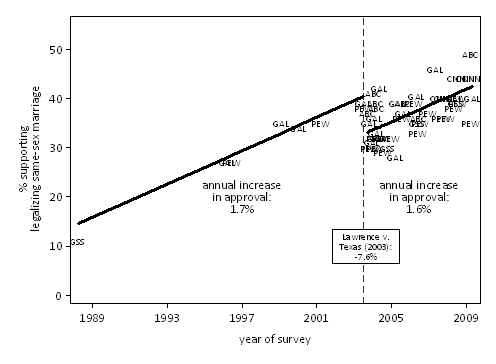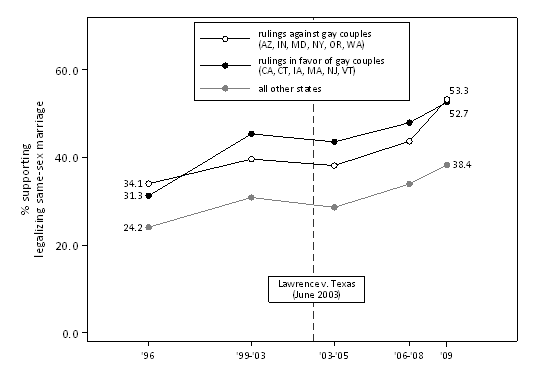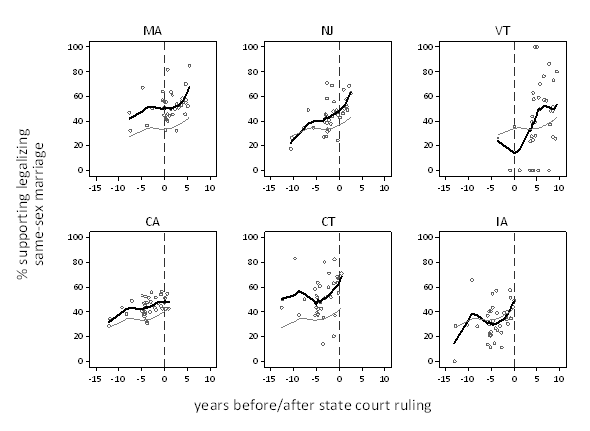|
Court Decisions and Trends in
Support for
Same-Sex Marriage
by Patrick J. Egan & Nathaniel
Persily
The trends in public support for same-sex marriage should interest both
those concerned about public attitudes toward gay rights and those with a
larger interest in the way court decisions help shape public opinion. The
political and legal dynamics of the same-sex marriage debate, as well as the
public opinion response, are unique. Nevertheless, analogies to other legal
contexts, such as abortion, desegregation and interracial marriage, help
define the stakes in this debate and the potential directions in which
public opinion may turn. Our own research, as spelled out in our book
Public Opinion and Constitutional Controversy (Oxford 2008), suggests
that the public is growing increasingly more amenable to same-sex marriage
and that judicial decisions are unlikely to reverse that trend.
When it comes to speculating about the
effect of court decisions on public opinion, there are several potential
dynamics that researchers attempt to identify. The first, and most
prevalent, is stability --
the absence of an effect of court decisions on attitudes toward a
particular issue. Most court rulings do not involve salient issues
understandable to the mass public. Even when they do, the public (or a large
share of it) often has fixed opinions and court decisions do little to
dislodge them from their preconceived notions. However, in some cases,
opinion can change in response to a court decision. The phenomenon of
legitimation occurs when courts lead opinion by issuing a decision that
only later gains majority support from the public. By contrast, backlash
results when the public goes in the opposite direction of the court. If, for
example, the court establishes a new right, the public might backlash
against the exercise of such a right. Finally (and not mutually exclusive)
is the dynamic of polarization. A court decision polarizes the public
when it pushes groups to take more extreme positions even if it does not
change the overall distribution of support for a particular right or
principle.
Court decisions in 2003 and 2004 interrupted
-- but did not
bring to a halt -- a nationwide trend toward support for same-sex marriage.
Which phenomenon best explains the
relationship of court decisions to public opinion concerning same-sex
marriage? The answer, it turns out, depends on which period of polling data
one analyzes. The publicís approval of same-sex marriage has exhibited a
slow but steady upward trajectory over time. But this upward trend was
interrupted by the national debate that occurred over same-sex marriage in
the aftermath of high-profile court decisions regarding gay rights.
In June 2003, the U.S. Supreme Court
decriminalized gay sex in Lawrence v. Texas. In the next seven
months, the Massachusetts Supreme Judicial Court handed down two decisions
in Goodridge v. Mass. Depít of Health, which legalized same-sex
marriage in that state. The trend and its interruption are illustrated in
Figure 1, which displays aggregate responses about legalizing same-sex
marriage recorded in more than fifty national polls conducted between 1988
and the present.1
Figure 1
Support for Legal Recognition of Same-Sex Marriage, 1988-2009
Source for data:
pollingreport.com

As shown in the figure, Americansí
approval of same-sex marriage has been increasing steadily for the past two
decades. But a sharp decline in support did occur in the wake of Lawrence.
That case did not deal directly with the issue of same-sex marriage
(although Justice Antonin Scaliaís dissent in the case raised the specter of
it). Nevertheless, a highly salient debate over same-sex marriage began in
the wake of that decision. Almost immediately, support for same-sex marriage
dropped, fueled in large part by those who were strongly (as compared to
mildly) opposed. The downward trajectory continued through the much-reported
pair of decisions from Massachusetts in 2003 and 2004, and until the 2004
election, when same-sex marriage continued to be a salient political issue.
At the time, the elite debate was highly lopsided in favor of opponents, as
evidenced by the fact that virtually no member of Congress, let alone a
presidential candidate, was willing to express support for same-sex
marriage.
It took somewhere between four and
five years for Americansí support for the idea of legalizing same-sex
marriage (which we estimate to stand currently at 42%) to rise above pre-Lawrence
levels. However, by no means did those judicial decisions permanently stunt
the trend toward increased support for same-sex marriage: the rate of
increase in approval in the post-Lawrence era is virtually the same
as it was before the 2003 ruling. Scholarship has shown that this is due
both to shifting attitudes -- particularly among
those identifying as liberals -- and to
generational replacement. Moreover, strong majorities of Americans now
support some legal recognition (marriage or civil unions) for same-sex
couples.
Backlash to court decisions in favor of same-sex couples has
not occurred at the state level.
All of the recent highly salient court
activity regarding same-sex marriage has taken place at the state, not the
federal level. In six states -- California (2008),
Connecticut (2008), Iowa (2009), Massachusetts (2003), New Jersey (2006) and
Vermont (1999) -- high courts have issued rulings
resulting in the legal recognition of same-sex couples.2 In
addition, statewide rulings against same-sex marriage have been
handed down in seven states: Alaska (1999), Arizona (2003), Indiana (2005),
Maryland (2007), New York (2006), Oregon (2005) and Washington (2006).3
This variation in outcomes provides us
with a unique opportunity to further explore the relationship between
high-impact court decisions and public opinion. Have pro-gay rights rulings
in the states led to a sharp decline in state-level approval of same-sex
marriage? Or, by contrast, have these rulings --
and the policies changed as a result -- caused a
stateís residents to soften their opposition to the idea?
To explore these questions, we
assembled a dataset of more than 50,000 respondents to surveys on same-sex
marriage conducted by CNN, Gallup, and Pew over the past 13 years. The
dataset incorporates interviews conducted between March 1996 and April 2009
with nationally representative samples where individual-level data are
currently available.4 Critically for our purposes, the data
include interviews before and after the ruling date in every state where a
court ruling was issued (except Alaska, whose residents are not surveyed in
national polls). The dataset includes nearly 4,000 respondents interviewed
in the spring of 1996, just as the national controversy about same-sex
marriage was getting under way and shortly before President Clinton signed
the Defense of Marriage Act that September. These interviews
-- conducted before high courts in any of the states in our analysis
issued rulings on same-sex marriage -- serve as a
valuable baseline measure of public opinion on the issue.
Figure 2 is a straightforward
examination of the relationship between public opinion and state high court
rulings on same-sex marriage. It divides Americans into three groups: those
living in states with pro-gay rights court rulings; those with anti-gay
rights court rulings, and those with no high court rulings at all. The
figure tracks the percentage of Americans supporting legal same-sex marriage
in each of these three groups of states from 1996 to the present.
Figure 2
Support for Legal Recognition of Same-Sex Marriage, 1996-2009
Source for data: Surveys
conducted by CNN/Opinion Research Corporation, Gallup, and the Pew Research
Center (distributed by the Roper Center Public Opinion Archives, University
of Connecticut)

Several interesting insights are
provided by Figure 2. First, it is clear that residents of states in which
high courts have issued rulings on same-sex marriage have always been more
supportive of legal recognition than other Americans. In 1996, support for
same-sex marriage in states that would eventually issue court rulings was in
the low 30s, while support among the remainder of Americans stood at (a
statistically significantly lower) 24%. Upon reflection, this should not be
too surprising: gay rights advocates have undoubtedly been strategic about
filing lawsuits where public opinion is more supportive of their cause.
Furthermore, such cases are more likely to reach consideration by high
courts (rather than being tossed out by lower courts) to the extent that a
state has a liberal judiciary. However, among those states where court
rulings have been issued, no significant difference in opinion on same-sex
marriage existed in 1996 between states that would eventually issue rulings
favorable to gay rights and those that would issue unfavorable decisions. In
other words, we could not have used state opinion in 1996 to predict how
state courts would eventually rule on lawsuits seeking legal recognition of
same-sex marriage.
To return to our original question,
the data provide no evidence of any sort of state-level backlash to state
court decisions protective of gay rights akin to the nationwide drop in
support for same-sex marriage seen in the wake of Lawrence in 2003.
Support increased by 21 percentage points between 1996 and 2009 in states
with pro-marriage court rulings, compared to an increase in support of 19
points in states with anti-marriage rulings and 14 points in states with no
rulings whatsoever.
Because this figure does not take into
account the timing of state court rulings, we look for evidence of backlash
in a different way in Figure 3. Here, we examine the survey data on a
state-by-state basis with scatterplots for each of the six states where
courts have issued rulings leading to the legal recognition of same-sex
couples. Each scatterplot point represents one survey from our dataset, and
it indicates the level of support for same-sex marriage in the state by the
number of years before or after that stateís high court ruling was issued.
The year in which a court ruling was issued is denoted "0" and indicated by
a dashed vertical line. A dark line traces the smoothed trend of the state
opinion data.5 For comparison purposes, a gray line traces the
concurrent national trend in opinion on same-sex marriage. (This trend is
shifted to the left or right in each graph according to when the state court
decision took place.)
Figure 3
Support for Legal Recognition of Same-Sex Marriage in States with Pro-Gay
High Court Rulings, 1996-2009 (by Number of Years Before or After Ruling)
Source for data: Surveys conducted by CNN/Opinion Research Corporation,
Gallup, and the Pew Research Center (distributed by the Roper Center Public
Opinion Archives, University of Connecticut)


The three states at the top of the
figure -- Massachusetts, New Jersey, and Vermont
-- are those where a court ruling has been in place for the longest
time. In each of these states, support for same-sex marriage has risen more
quickly than national opinion since the court ruling was issued. The three
states at the bottom of the figure -- California,
Connecticut, and Iowa -- have comparably much less
experience with same-sex marriage, making it difficult to draw conclusions
about whether rulings in these states will ultimately be followed by a
change in public opinion. And California -- where
voters banned same-sex marriage less than six months after the court handed
down its ruling -- may well prove to be a special
case. But as of yet, polling does not indicate a steep drop in support for
same-sex marriage in any of these three states. In fact, it is reasonable to
draw the conclusion that state residents tend to adapt to pro-marriage
rulings (in response to either the rulings, the resulting change in the law,
or both) by becoming more supportive of legally recognizing same-sex
marriages.6
Of course, itís likely that state high
courts have anticipated how public opinion would react to their decisions
and issued rulings with this in mind. Thus we canít say for sure whether
these patterns would hold true for other states in the future. But the data
presented here provide no support for the common speculation that state
court rulings in favor of same-sex couples generate a public opinion
backlash.
Conclusion
If current trends continue, a majority of Americans will support same-sex
marriage by the year 2014. While majority support does not always lead to
movement in policy, the tone of the national debate would likely change
significantly if support for gay marriage can no longer be written off as a
minority viewpoint. But should we expect current trends to remain in place?
There may be exceptional events that would nudge public opinion off of its
projected trajectory. The President could come out in favor of legalization
of same-sex marriage, or the Supreme Court could strike down bans on such
marriages, for example. Or, less likely, Congress could pass a
constitutional amendment banning such marriages that might spark a debate
uncharacteristic to what we have heretofore witnessed. But the past tells us
that the most likely outcome in the future is consistent change: a steady
movement in opinion caused by larger cultural and demographic forces that
overwhelm any individually salient political events.
1 The polls were
conducted by ABC News/Washington Post (denoted in the figure as ABC),
CNN/Opinion Research Corporation (CNN), Gallup (GAL), the General Social
Survey/NORC (GSS), and the Pew Research Center (PEW). Most of these data may
be found in the pollingreport.com archives. We used a statistical technique
called regression analysis to detect and estimate "house effects" (that is,
consistent biases associated with each polling firm). The trend lines drawn
in Figure 1 are linear fits adjusted for these estimated house effects. (We
also conducted nonparametric analyses -- which do not assume a linear opinion
trend -- and obtained similar results.) All data discussed here are weighted
with the sampling weights provided by the polling firms.
2 Same-sex couples were able to marry legally in California from June
16 through November 4, 2008, when officials ceased issuing marriage licenses
after the passage of the Proposition 8 ballot initiative amending the state
constitution to ban same-sex marriages.
3 Two of these rulings (in Arizona and Indiana) were issued by
intermediate appellate courts with statewide jurisdiction, rather than the
states' highest courts. We include them here because both attracted
statewide attention, and one decision (Arizona's) was allowed to stand
without comment by the state supreme court; the other (Indiana's) was never
appealed to that state's supreme court. Not included here is Baker v.
Nelson, an anti-marriage ruling by the Minnesota Supreme Court in 1971 that
was upheld by the U.S. Supreme Court -- nor the Baehr cases before the Hawaii
Supreme Court (1993, 1996, 1999), which unlike the other pro-marriage cases
here did not lead directly to the legal recognition of same-sex couples.
4 These data are archived and distributed by the Roper Center Public
Opinion Archives at the University of Connecticut. As is typically the case
in national surveys of Americans, Alaska and Hawaii residents are not
included in the samples.
5 The state-level sample sizes for each survey can be quite small -- and
for small states, in the single digits -- so we focus on the overall trend
rather than on individual data points.
6 We have further explored these questions with multivariate analyses
(not shown here) that control for potentially confounding factors, notably
concurrent national trends in opinion, the ideology of state residents, and
any pre-existing differences among state residents in their support for
same-sex marriage (that is, state "fixed effects"). We have also checked to
make sure that the results are not driven by data from any one state in
particular. These analyses support the observations made here, and find that
opinion in states with pro-gay rulings has moved in a significantly more
supportive direction after the issuance of court decisions than has opinion
in states with anti-gay rulings.
Copyright © 2009 POLLING REPORT, INC.
|
. . . Americans'
approval of same-sex marriage has been increasing steadily for the past
two decades.
. . . the rate of
increase in approval in the post-Lawrence era is virtually the same as it
was before the 2003 ruling.
. . . the data presented here provide no support for the common
speculation that state court rulings in favor of same-sex couples generate
a public opinion backlash.
But the past tells us that the most likely outcome in the future is
consistent change: a steady movement in opinion caused by larger cultural
and demographic forces that overwhelm any individually salient political
events.
|